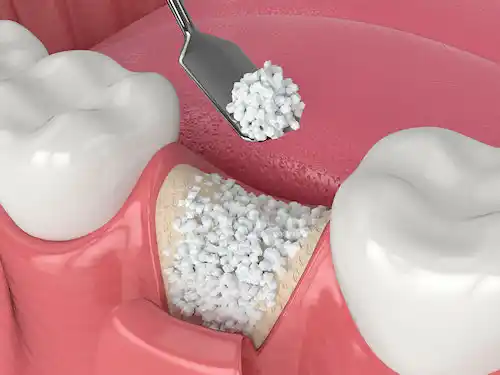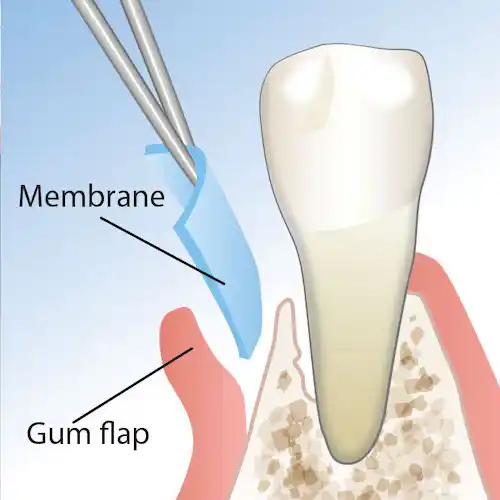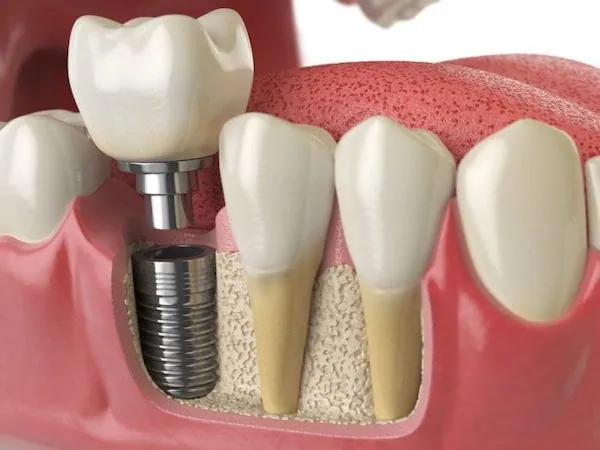Bone grafts and membranes have revolutionized the field of dentistry, enabling remarkable advancements in extraction procedures. In this blog post, we will explore the state-of-the-art techniques and innovations in bone grafting and membrane usage, highlighting their benefits, applications, and future prospects.
An Overview of Bone Grafting and Membranes
Bone grafting is a technique used to replace or stimulate the growth of missing bone. It involves the transplantation of bone or bone-like materials to the site where bone regeneration is desired. By providing a scaffold for new bone formation, bone grafts facilitate the healing process and enable successful dental procedures.
Membranes, on the other hand, play a crucial role in guided tissue regeneration (GTR) procedures. They act as barriers, preventing unwanted soft tissue infiltration into the graft site while allowing for the migration and proliferation of bone-forming cells. Membranes can be classified into resorbable and non-resorbable types, depending on their degradation characteristics.
Different types of bone grafts are available for use in dental procedures. Autografts involve using the patient’s own bone, harvested from another site in the body. Allografts use bone from a donor, either from a cadaver or a tissue bank. Xenografts utilize bone derived from animal sources, such as bovine or porcine. Synthetic graft materials, such as hydroxyapatite or calcium phosphate, offer alternative options for patients with specific needs.
Before performing a bone grafting procedure, assessing the quality of the patient’s existing bone is essential. This evaluation helps determine the appropriate type and amount of graft material required for optimal outcomes. Diagnostic imaging, such as cone-beam computed tomography (CBCT), aids in the assessment process.

Advancements in Bone Grafting Techniques
Socket preservation is a technique aimed at minimizing bone loss following tooth extraction. The process involves placing a bone graft material directly into the extraction socket. This approach promotes the preservation of the natural bone contour and prevents subsequent bone resorption, providing a solid foundation for future implant placement.
Ridge augmentation is another area that has witnessed significant advancements. It involves the use of bone grafts to augment and reconstruct the alveolar ridge, restoring its height and width. This technique is crucial when the ridge lacks sufficient bone volume for successful implant placement. Innovative grafting materials and techniques, such as particulate grafts, block grafts, and split-crest procedures, have improved the predictability and success rates of ridge augmentation procedures.
Sinus lifts, or maxillary sinus floor augmentation, are commonly performed to increase the bone height in the posterior maxilla for dental implant placement. The procedure involves lifting the sinus membrane and filling the space below it with bone graft material. Advancements in sinus lift techniques, such as the minimally invasive lateral window approach and crestal approach using osteotomes, have made the procedure more predictable and less invasive.
In recent years, navigated bone grafting techniques have emerged as a cutting-edge approach. Computer-guided systems enable precise preoperative planning and real-time intraoperative guidance, enhancing the accuracy and efficiency of bone graft placement. The use of navigation systems minimizes surgical errors, reduces patient discomfort, and facilitates quicker healing.
Cutting-Edge Membrane Applications
Guided tissue regeneration (GTR) is a technique that uses membranes to create a protected space for the regeneration of periodontal tissues. By placing a barrier membrane between the soft tissues and the defect site, GTR prevents the migration of epithelial cells and allows the proliferation of periodontal ligament cells and bone-forming cells, promoting the regeneration of periodontal tissues.

Barrier membranes are also employed in socket preservation procedures. Placing a membrane over the bone graft material helps stabilize it, prevent soft tissue invasion, and promote the formation of new bone within the socket. This approach significantly improves the long-term preservation of the extraction socket and facilitates subsequent implant placement.
Membrane-assisted ridge augmentation involves the use of membranes to stabilize the
graft material during ridge augmentation procedures. By creating a barrier, the membrane prevents the migration of soft tissue cells into the graft site, facilitating the regeneration of new bone. Membrane-supported ridge augmentation techniques have shown remarkable success rates and have become an integral part of advanced bone grafting procedures.
Similarly, membranes play a critical role in sinus lifts. During maxillary sinus grafting, the membrane helps maintain the space created below the lifted sinus membrane, ensuring optimal graft integration and subsequent implant success. Membrane-supported sinus lifts provide a stable environment for bone regeneration and contribute to improved clinical outcomes.
Challenges and Future Directions
Advancements in biomaterials have the potential to revolutionize bone grafting outcomes. Researchers are exploring the use of growth factors, bioactive molecules, and tissue-engineered constructs to enhance bone regeneration. The integration of these biomaterials into bone grafting procedures can accelerate healing, promote tissue integration, and improve overall clinical outcomes.
Membrane technology is also advancing rapidly. New membrane designs and materials are being developed to optimize the barrier properties, degradation rates, and handling characteristics. Resorbable membranes with controlled release properties, customizable shapes, and improved tissue integration capabilities are expected to enhance the success rates of guided bone regeneration procedures.
Tissue engineering and regenerative approaches hold great promise in the field of bone grafting. Scientists are working on developing techniques to cultivate patient-specific bone tissue in the lab, which can be subsequently transplanted into the defect site. These regenerative therapies aim to provide a renewable and biocompatible source of bone grafts, minimizing the need for donor materials.
Virtual planning and guided surgeries are becoming increasingly popular in bone grafting procedures. Through the use of advanced imaging techniques, such as CBCT and 3D models, virtual treatment planning enables precise preoperative analysis, accurate graft placement, and improved clinical outcomes. Additionally, computer-guided implant surgeries and robotic-assisted procedures are being explored to enhance the precision and efficiency of bone grafting.
Need an extraction? Consider dental implants afterward
Why You Should Get Dental Implants After an Extraction
There are several reasons why you might consider getting dental implants after an extraction:
1. Restoring Function
Dental implants provide a functional replacement for the missing tooth. They are designed to mimic the natural tooth root and offer stability and support for biting and chewing. By getting a dental implant, you can regain the ability to eat and speak properly, improving your overall quality of life.
2. Maintaining Jawbone Health
When a tooth is extracted, the underlying jawbone can begin to deteriorate over time due to lack of stimulation. Dental implants stimulate the jawbone through the process of osseointegration, where the implant fuses with the bone. This helps preserve the bone structure and prevent further bone loss. Without an implant, the surrounding bone may start to resorb, potentially leading to changes in facial appearance and shifting of neighboring teeth.
3. Preventing Shifting of Teeth
After a tooth extraction, neighboring teeth can gradually shift and move into the empty space, causing misalignment and bite problems. By replacing the extracted tooth with a dental implant, you maintain proper spacing and alignment of your teeth, preventing these issues and preserving the overall integrity of your dental arch.
4. Aesthetic Considerations
Missing teeth can have a significant impact on your smile and facial appearance. Dental implants provide a natural-looking and aesthetically pleasing solution for replacing missing teeth. They are custom-made to blend seamlessly with your existing teeth, enhancing your smile and boosting your self-confidence.
5. Long-Term Durability
Dental implants are known for their durability and longevity. With proper care and maintenance, implants can last for many years or even a lifetime. Compared to other tooth replacement options, such as dentures or bridges, implants offer a more permanent and stable solution.
6. Improved Oral Health
Dental implants do not require altering or compromising adjacent teeth, as is often the case with dental bridges. By opting for an implant, you can maintain the health and integrity of your remaining natural teeth. Implants are also easy to clean and maintain, just like your natural teeth, promoting good oral hygiene and reducing the risk of dental issues in the future.
It’s important to consult with a qualified dental professional who can evaluate your specific case and provide personalized recommendations. They will consider factors such as your overall oral health, bone condition, and treatment goals to determine if dental implants are the best option for you after an extraction.
Extracted Tooth as a Precondition for Implant Placement
In many cases, a dental extraction is necessary before a dental implant can be placed. If a tooth is severely damaged or compromised due to decay, trauma, or periodontal disease, extraction may be the recommended treatment option. After the tooth is extracted, the site is allowed to heal, and then a dental implant can be placed in the same location to restore the missing tooth.
Preservation of Extraction Socket for Future Implant Placement
In situations where a tooth extraction is required but immediate implant placement is not feasible, socket preservation techniques may be employed. Socket preservation involves placing bone graft material into the extraction socket immediately after tooth removal. This helps to maintain the volume and contours of the socket, preventing excessive bone loss. The preserved socket provides a more favorable environment for future dental implant placement, ensuring adequate bone support and improving the overall success of the implant procedure.
Ridge Augmentation for Implant Site Preparation
In cases where the alveolar ridge has experienced bone resorption or lacks sufficient width or height, ridge augmentation procedures may be performed. Ridge augmentation involves adding bone graft material to the deficient ridge area to rebuild or enhance its dimensions. This procedure creates a more suitable foundation for implant placement, ensuring optimal aesthetics and function. Ridge augmentation may be necessary prior to dental implant placement to ensure the long-term success of the implant by providing adequate bone support.
Extraction of Failing Teeth and Replacement with Implants
Dental extractions may be performed on teeth that are severely damaged, decayed, or non-restorable. In such cases, the failing tooth is extracted, and a dental implant is placed as a replacement. Implants serve as a stable and durable solution for tooth replacement, offering numerous benefits such as improved chewing ability, natural appearance, and preservation of jawbone structure. Dental implants provide a long-term solution for patients who have lost teeth due to various reasons, and they can significantly enhance oral health and quality of life.
Bone Graft and Membrane Techniques
Bone graft and membrane techniques are also closely related to dental implants
They play a crucial role in preparing the implant site and ensuring the long-term success of implant procedures. Here’s how they are connected:
Bone Volume and Density
Bone grafting techniques are used to augment or regenerate bone in areas where there is insufficient natural bone volume for dental implant placement. By adding bone graft material to the deficient area, bone volume and density can be improved, providing a solid foundation for implant stability. The bone graft acts as a scaffold, promoting new bone growth and integration with the surrounding natural bone. This process enhances the chances of successful implant osseointegration, ensuring the implant remains stable and durable over time.
Socket Preservation
When a tooth is extracted, the socket that remains can undergo bone resorption and lead to the loss of bone volume. Socket preservation involves placing bone graft material immediately after tooth extraction to maintain the dimensions of the extraction socket. By preserving the socket, bone loss is minimized, and the site is better prepared for subsequent dental implant placement. The bone graft helps retain the natural bone contour, facilitating optimal implant positioning and stability.
Ridge Augmentation
In cases where the alveolar ridge lacks adequate height or width, ridge augmentation techniques are employed to augment the ridge before dental implant placement. Bone grafts are used to rebuild or augment the deficient areas of the ridge, creating a more suitable site for implant placement. Ridge augmentation techniques help establish a proper bone foundation, enabling the implant to be placed in an ideal position for optimal aesthetics and function.
Sinus Lifts
Maxillary sinus lifts, or sinus floor augmentation, are performed when the maxillary sinus is too close to the upper jaw, limiting the available bone height for implant placement in the posterior region. In this procedure, the sinus membrane is lifted, and bone graft material is added to the space created between the sinus floor and the ridge.
This creates additional bone volume in the posterior maxilla, allowing for successful implant integration. Sinus lifts are essential in cases where implants are desired in the upper molar and premolar areas.

Guided Tissue Regeneration
Membrane techniques are employed in guided tissue regeneration (GTR) procedures to promote the selective growth of bone and connective tissues while preventing the infiltration of unwanted soft tissue cells. Barrier membranes are placed between the bone graft material and the surrounding soft tissues to create a protected space. This space allows bone-forming cells to populate the graft site, leading to the regeneration of bone, which is crucial for the integration and stability of dental implants.
In summary, bone graft and membrane techniques are integral to the success of dental implant procedures. They contribute to the preparation and augmentation of the implant site, ensuring sufficient bone volume and density for stable implant placement. These techniques facilitate osseointegration, improve implant stability, and enhance long-term implant success rates.
Dental implants do not require altering or compromising adjacent teeth, as is often the case with dental bridges. By opting for an implant, you can maintain the health and integrity of your remaining natural teeth.
Implants are also easy to clean and maintain, just like your natural teeth, promoting good oral hygiene and reducing the risk of dental issues in the future.
It’s important to consult with a qualified dental professional who can evaluate your specific case and provide personalized recommendations.
They will consider factors such as your overall oral health, bone condition, and treatment goals to determine if dental implants are the best option for you after an extraction.
Dental Extractions and Dental Implants
Dental extractions and dental implants are related in the context of replacing missing teeth. Here’s how they are connected:
Extracted Tooth as a Precondition for Implant Placement
In many cases, a dental extraction is necessary before a dental implant can be placed. If a tooth is severely damaged or compromised due to decay, trauma, or periodontal disease, extraction may be the recommended treatment option.
After the tooth is extracted, the site is allowed to heal, and then a dental implant can be placed in the same location to restore the missing tooth or teeth.

Preservation of Extraction Socket for Future Implant Placement
In situations where a tooth extraction is required but immediate implant placement is not feasible, socket preservation techniques may be employed. Socket preservation involves placing bone graft material into the extraction socket immediately after tooth removal.
This helps to maintain the volume and contours of the socket, preventing excessive bone loss. The preserved socket provides a more favorable environment for future dental implant placement, ensuring adequate bone support and improving the overall success of the implant procedure.
Ridge Augmentation for Implant Site Preparation
In cases where the alveolar ridge has experienced bone resorption or lacks sufficient width or height, ridge augmentation procedures may be performed. Ridge augmentation involves adding bone graft material to the deficient ridge area to rebuild or enhance its dimensions.
This procedure creates a more suitable foundation for implant placement, ensuring optimal aesthetics and function. Ridge augmentation may be necessary prior to dental implant placement to ensure the long-term success of the implant by providing adequate bone support.
Extraction of Failing Teeth and Replacement with Implants
Dental extractions may be performed on teeth that are severely damaged, decayed, or non-restorable. In such cases, the failing tooth is extracted, and a dental implant is placed as a replacement.
Implants serve as a stable and durable solution for tooth replacement, offering numerous benefits such as improved chewing ability, natural appearance, and preservation of jawbone structure.
Dental implants provide a long-term solution for patients who have lost teeth due to various reasons, and they can significantly enhance oral health and quality of life.




